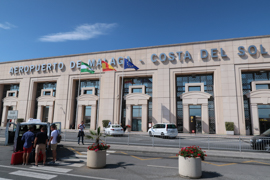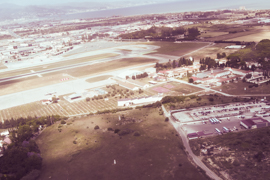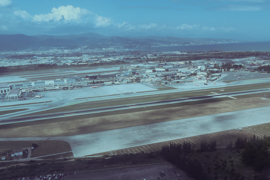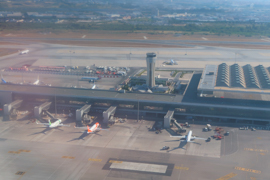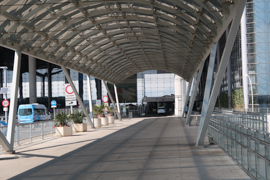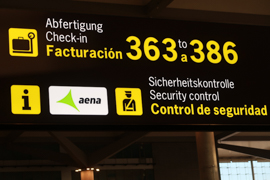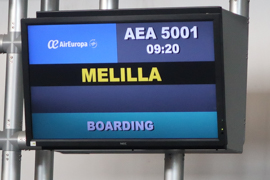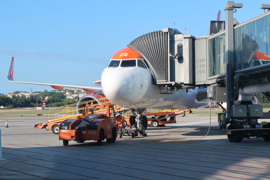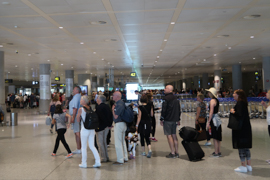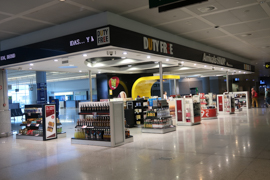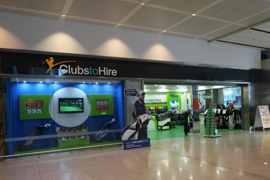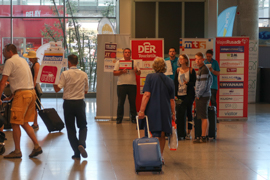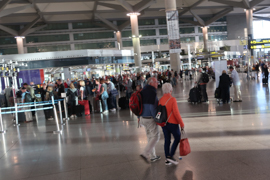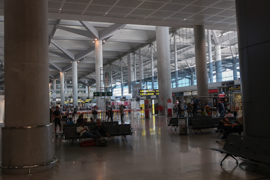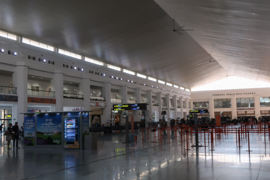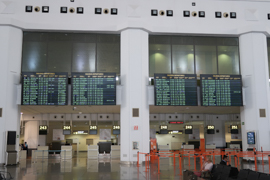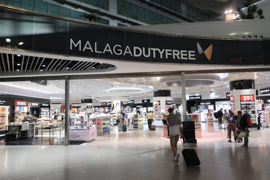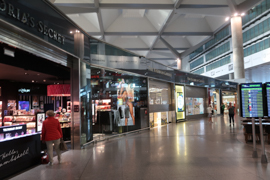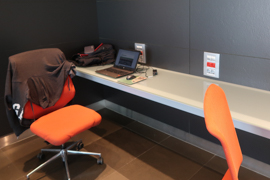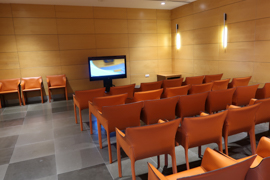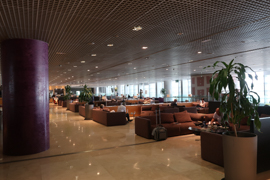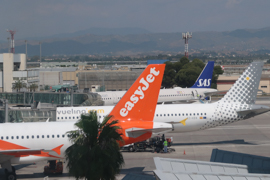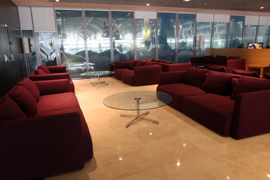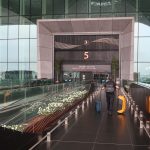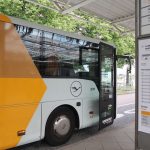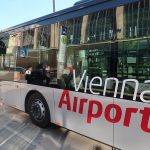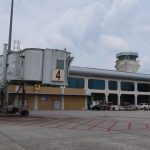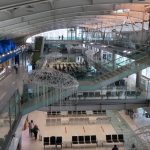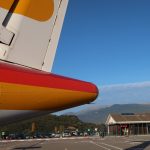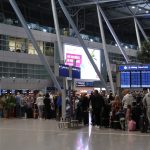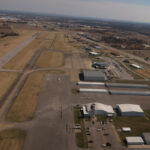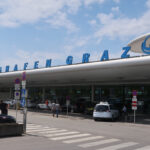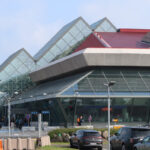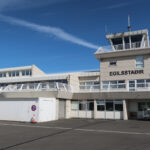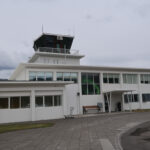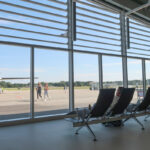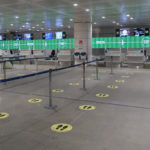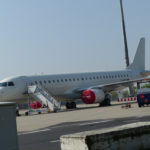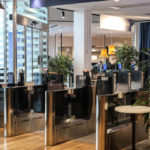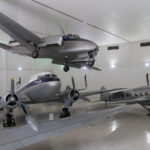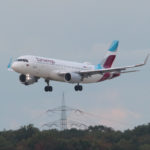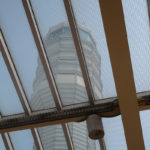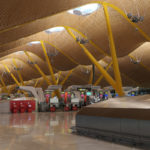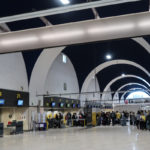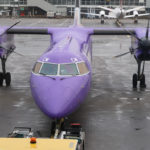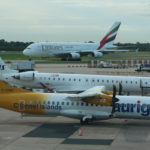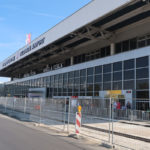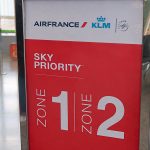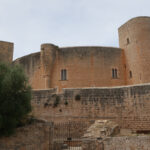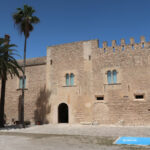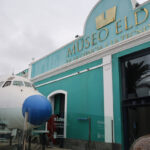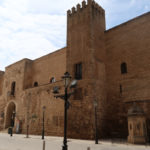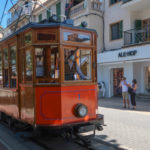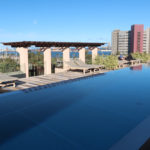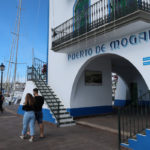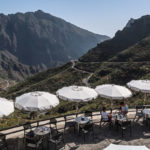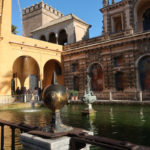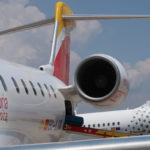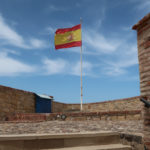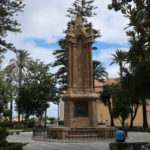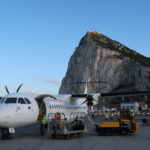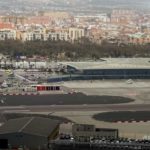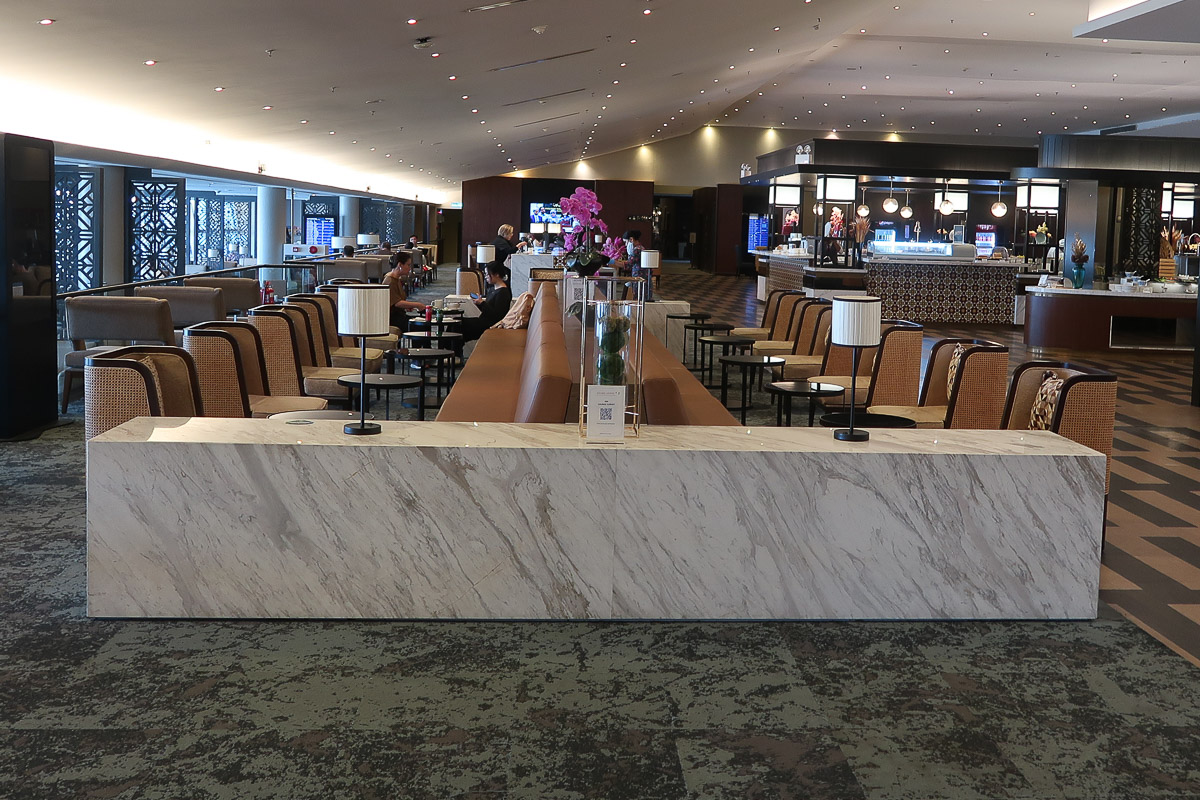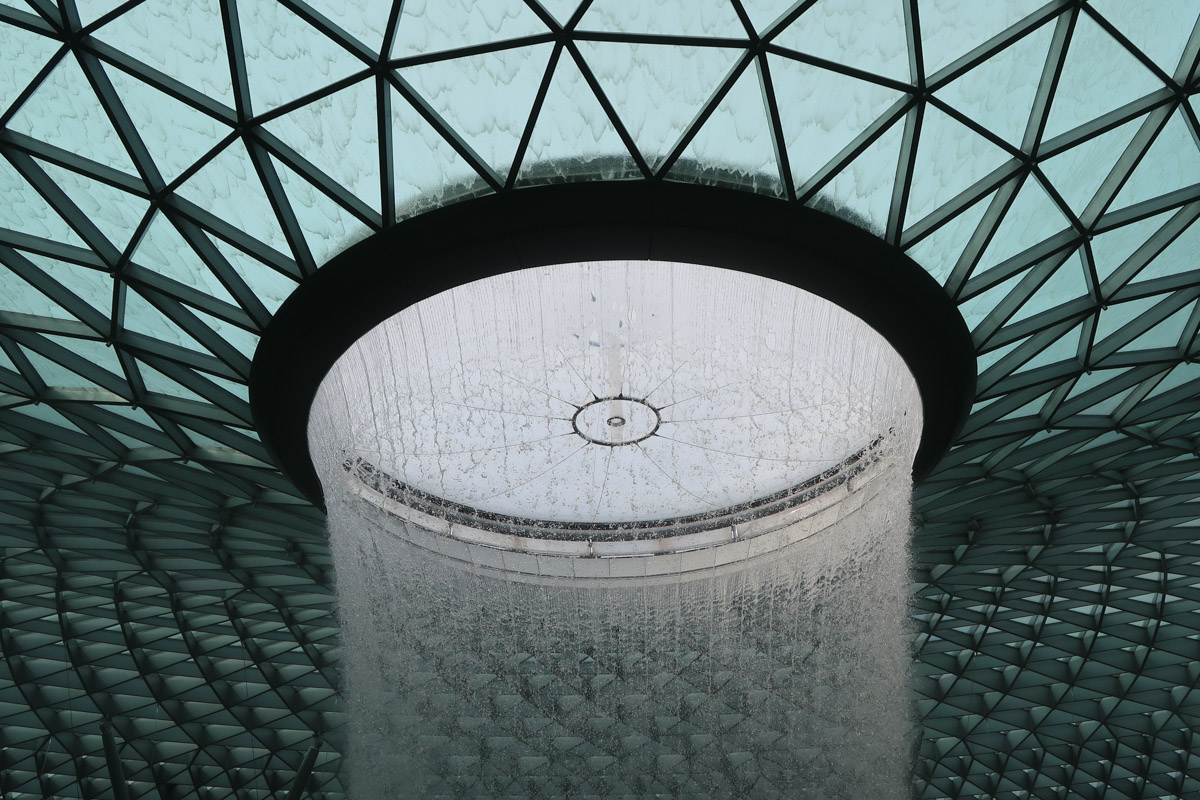Malaga Costa del Sol Airport
Flyctory.com Pros
- Very good transport connection
- A lot of shopping
- Historic Terminal 2
Flyctory.com Cons
- Crowded VIP Lounge
- Holiday Airport
If there wasn’t Palma, the “Costa del Sol” Airport of Malaga would be Spain’s premier holiday airport with more then 12m passengers annually. I did the airport a couple of times already (also because I love the city of Malaga) – so I did during my Six Intercontinental Flight weekend for four legs, an arrival from Ceuta by Helity (Day 3 of the trip), a return flight daytrip to Melilla (Day 4) and returning back to Germany on the fifth and final day.
Here is my review of the “Costa del Sol” airport, which of course also includes my experience of previous connections.




Malaga AGP – Location and Traffic
Malaga Airport is quite closely to the center. It is a about a ten kilometer distance from city center to the key aviation grounds of Costa del Sol. Many people likely arrive here by rental car, just because they want to explore Costa del Sol or Andalusia. However, the connections to the city and the surroundings are excellent: there is an express bus, Line A, which takes some 20 minutes to Malaga and just costs 3 EUR. There are two to three departures in front of the airport terminal per hour. Taking the local Renfe commuter train is even cheaper, with some 1.80 Euro per trip and a quicker travelling time of slightly more than ten minutes. The additional advantage of that option is that it does not only go Northbounds to the city, but also connects to some cities at the closeby coastline like tourist magnets Torremolinos and Fuengirola (final stop, higher fee). Taxis from the airport have a minimal fee of 20 Euro.
In my Six International Flight weekend Day 3 posting, I wrote about that none of the hotels closeby do have a shuttle or a good connection to the airport. Some are somehow connected by the express bus line. This shows, how specialised the infrastructure of the airport is for holiday business. In general, I felt that the best connection are hotels, which are closeby the Renfe commuter line and/or by bus, and chose the Sercotel close to Malaga’s main station.

Malaga AGP – Flight Connections
The key business of Malaga airport is holiday travel – especially in summer season, you more or less may connect to any location in Europe you may imagine (including rather exotic aiports like Liverpool, Malmö or Antwerp). I also spotted a Delta airlines service to New York, but that is definitely not Malaga’s characteristic type of flight. Of course, there are also connections to all over Spain – one of the most interesting ones was the one I took on the third day of my Six Intercontinental Flight weekend in the Mediterranean: the Spanish helicopter airlines Helity is offering connections to Spain’s North African exclave Ceuta. There is a massive number of flights from Germany. Even the displays in the airport give German wordings.




Arriving at Malaga Airport (AGP)
If you arrive at Malaga Airport for the first time, you might be overwhelmed by its cheer imensity. The luggage belts are numbered up to 42 – and even if there are a few belt numbers missing, it feels like a cathedral of European luggage. Funnily, just four belts are assigned to non-EU flights (which also covers the services to duty-free Spanish areas like Melilla and Ceuta). This shows the importance of the airport for European travel rather than being a worldwide travel hub.
After you got your luggage, you might go to one of the many rental car offices, which are situated a level below. Furthermore, there is an arrival duty free. There are some special services close to the arrival area exit: the first eye-catcher is a “rent-a-golf equipment” store, which shows a decent popularity of that sports in the area. A couple of steps ahead, you might be lost in a horde of travel agency agents bringing their customers to the correct transfer buses. Malaga is a holiday destination – and this very often simply means package holidaying.






Malaga Airport AGP – Check-In
If you depart from Malaga in the high summer holiday season, you will be togehter with masses of people (especially on those days, where travel agencies typically do their inbound and outbound flights). In theory, Malaga offers three terminals, but Terminal 1 is closed (there are rumours that it will be renovated and re-opened in the future). There is no real split between Terminal 2 and 3 – you will majorly see that there are two different buildings just due to their very different designs. The older one, Terminal 3, is thereby majorly used by charter and holiday airlines. More established airlines like Iberia, Lufthansa Group or Air Europe are all located in the more modern area. Security is in Terminal 3.
During my May visit visit the security seemed to be efficient even with quite long queues. However, there are frequent reports about the airside security collapsing in summer which leads to massive waiting times there – I did have similar experience despite fast track access in summer 2017 as well.




Malaga Airport AGP – Shops and Restaurants
As a holiday airport, you of course want to get your passenger’s final reserves when they do their last steps on Spanish soil. The massive Duty Free area gets its job done! Compared to Madrid, it is sometimes slightly more expansive, but it has a similar, maybe even better variety. There are also some nice specialized stores like Victoria’s Secret or a shop for Spanish delicious food (if you fancy to go back home with a complete Serrano ham, that’s the place to go…).
After the duty free area, there are also some eatery places, from Burger King to pub-alike food. Shopping seems to be much more in focus, though.






Malaga Airport AGP – The Lounge
Regardless that the airport is rather major, there is just the Sala VIP option if you want to have lounge access. The AENA (Spanish airport authority) operated lounge is huge, I would assume it to easily hold 500 passengers. However, in summer it can be very busy. The atmosphere is quite cozy with a lot of sofas, but most of the separated areas hold roughly ten people. At the very end of the lounge, there is a working space area and a children cinema. Toilets are located on both sides of the lounge. There is a lot of wine and limited other alcoholic drinks – the food offered does not exceed other Spanish lounges (which means that you are typically more than happy if you happen to grab a packed pasta salad). It is not fully terrible, but it is also not a lounge I would rate good in any regard.






Fun fact about Malaga Airport
Did you ever ask yourself, how the Malaga Airport IATA code, AGP, fits into the name of the city or the name of the Airport, Costa del Sol? The reason is that until 2011, the airport has been named after Pablo Ruiz Picasso and called “Aeropuerto Gran Picasso”, which form the abbreviation. The renaming to “Costa del Sol” airport was of course supported by the tourism industry around the airport. I even found an article that they were aiming to change the AITA code to SOL. As this code is now taken by the Solomon State Field in Alaska, I don’t believe this change will ever happen.
Malaga Airport (AGP) – My View
I am not a special fan (or hater) of Costa del Sol Airport. AGP just got what an airport of this size needs. There is not too much character in this airport, maybe the historic Terminal 2 is something special. On the positive side, there is definitely the excellent connection to Malaga city (which is an absolute pearl – you should visit that!) and the nice shopping facilities. It is a holiday airport, which means that you just face many people who do not fly regularly which reduces efficiency of operations at the typical bottleneck points. The VIP lounge is huge. Finally, I feel that only the Iberia lounges in Madrid are really great places in that country. Compared to minor Spanish airports like Seville, Malaga is a an absolute treat. Malaga is a nice hub, as efficient as it can realistically be, so that you will enjoy it somehow when you are around!
Airports on Flyctory.com
Here are all other airport-related postings:

The best (i.e. most economic) way to integrate a day in Charlotte, North Carolina, to my Six US States and Nashville trip ...

Dusseldorf Airport (DUS) used to be a great place for plane spotters and aviation geeks. Two visitor terraces, one at ...

Istanbul Airport (IST, Turkish: İstanbul Havalimanı) opened in 2018, mainly in order to strengthen the global role of Turkish Airlines ...

I really like flying to or from Munich Airport (MUC) or having a transfer there (at least in Lufthansa's Terminal ...

In late May 2025, I added another smaller US airport to my flight log. Typically, I visit these places due ...

In late June 2025, I had my 210th airport experience. Going to Brighton in Southern England, the early morning KLM ...

For the Rock of Ages show in Vienna in April 2024, I opted for the B&B Hotel Stadthalle. As the hotel is ...

It's already quite a while ago since I shared my view on Dubrovnik Airport (DBV) with you. However, I did ...

After I already took you on a Visitor Tour through Munich Airport (MUC) in a previous post, here is another ...

The 2025 Rock of Ages shows in Cologne (I visited all of them...) gave me the opportunity to have a closer ...

In October 2024, I flew from Jakarta (CGK) Terminal 3 back to Abu Dhabi (AUH) via Colombo (CMB). The SriLankan ...

During my Pittsburgh Penguins trip in February 2025, I had a Contour Airlines flights, based on the Essential Air Service ...

Flying Eurowings in the A320neo from Cologne/Bonn (CGN) to Dubai World Central (DWC) did not only give me my first-ever ...

The Essential Air Service program, a state-funded scheme to subsidize aviation in more remote and less developed areas, already brought ...

In addition to the non-Schengen services at Terminal 1, Terminal 2 of Prague Airport (PRG) offers two lounge options. I ...

Dubai World Central (DWC), also Dubai Al Maktoum International, is Dubai's future hub in the making, according to the official ...

Like I did in 2023, I will kick off my looking back to the year 2024 with some travel facts ...

Spending some time in and around Munich Airport (MUC), I also took the opportunity to have their Airport-Live-Tour, the basic bus tour ...

Airport trains are a very convenient option to get to an airport. The Arlanda Express in Stockholm, for example, makes ...

Having a 1,000 EUR business class flight with Saudia to Kuala Lumpur just felt too tempting for me. The downside ...

Myrtle Beach in South Carolina is definitely a special place to me. The city on the Atlantic coast is full ...

When I traveled to Malaysia in February 2024, I was really curious about Johor Bahru. The city in the South ...

During my early 2024 trip to Malaysia, I had domestic ATR 72 flights with Firefly. The key hub of the ...

The history of Berlin nowadays is also a story of two airports which have been closed down in the meantime ...

Krakow is one of my favorite places in Poland. While I also took the lengthy train ride from Cologne once, ...

The Öresund Bridge connecting Copenhagen in Denmark and Malmö in Sweden revolutionized did not only revolutionize travel and transport between ...

In December 2022, I had my very first visit to Albania. The trip was, of course, by air, so that ...

Even though I really enjoyed my trip with Saudia Airlines from Tunis (TUN) to Kuala Lumpur (KUL), the transfer times ...

While I used the ferry some ten years ago to visit the Faroe Islands, I was really flattered to fly ...

The public transport situation of Dusseldorf Airport (DUS) is a bit more complex than it might feel at first sight ...

Having a mileage run via Marrakesh was just the second time I set foot on Moroccan soil. Like at the ...

The Heathrow Express, the Elizabeth Line or the good, old Piccadilly Line - there are many transport options to get ...

Visiting Cyprus in October 2022 was definitely one of the highlights of my previous year. I fell in love with ...

Due to the geographic situation of the Croatian coast, which is very long and thin along the Adriatic Sea, there ...

With the introduction of Elizabeth Line, there is now a third option to get from Heathrow Airport (LHR) to the ...

Especially with British Airways moving the vast majority of their operations from B-Gates to C-Gates, I have been frequently visiting ...

Especially when airports are located a little outside the city, airport express trains feel to be the perfect mass transportation ...

Already in 2018, I introduced you to my thoughts about Manchester Airport (MAN). To sum it up: the airport has ...

Dud you ever feel like learning more about the current operations and future plans of Germany's largest airport? Frankfurt Airport ...

This airport is likely one of the least frequented airports in Europe with regular scheduled services. You just have the ...

Malta was the destination of choice for my wife and myself during Easter 2022. Staying at the Hilton Malta, we ...

Traveling to the Scottish Highlands - a Rock of Ages musical trip in August 2022 lead to a trip quite to the ...

Tupelo, birth town of Elvis Presley. I felt very flattered that I would make it back to the city during ...

Adding a rail connection for Heathrow Airport, improving the travel options between the West and the East of London - ...

Early summer 2022. After the Covid-19 crisis feels to have come to a certain end, air travelers all over Europe ...

If you are not a general aviation pilot and "just" an aviation nerd or traveler, flying Helgoland Airport (HGL) is ...

The seventh day of my Pittsburgh Penguins trip in March 2022 lead me to Marion, Southern Illinois. The local Veterans ...

In summer 2021, I had a weeekend in Graz in Styria, Austria. Apart from meeting a wonderful friend again, I ...

There is currently some effort to establish regular international flights from Akureyri (AEY) again, but in general, if you approach ...

For our trip in late summer 2021 to Gdansk in Poland , my wife and I arrived in the city ...

Icelandair gave me a very short-term cancellation for my flight to Vestmannaeyear, when I visited the island. However, I definitely ...

There are a couple of LOT intercontinental flights from Warsaw Airport (WAW) in my flight log. Based on that, I ...

Flying from Reykjavik Domestic Airport (RKV) was thought to be one of the highlights of my trip to Iceland in ...

Milan-Malpensa Airport (MXP) is the major of the two airports serving the North Italian city. However, there is one issue ...

I had a couple of trips to Salzburg and neighboring areas in recent past. While some have been rail trip, ...

Even though I do have a couple of airport reviews on Flyctory.com, I so far missed a lot of the ...

South Tyrol, the German speaking region in Northern Italy is quite popular among tourists. The Dolomite Mountains attract many people ...

Flights directly from city to city - needless to say that one key driver of success of Billy Bishop - ...

In Iceland, Akureyri is called the Capital Of The North. Excluding the Reykjavik Metropolitan Area, it is the largest city on ...

I remember having a flight from Lübeck / Lubeck Airport (LBC) in the very early 2000's. At this time, I ...

Millions of tourists just cannot be too wrong: after Madrid Barajas (read my review of Terminal 4) and Barcelona El ...

Majorly in order to check out the DAT (Danish Air Transport) connection from there to Hamburg, I happened to fly ...

Even though I had to delay my flight from there for medical reasons, I was really excited to have my ...

My December 2020 trip to Gran Canaria / Grand Canary has been the first longer distance trip since quite a ...

There are a lot of discussions in Germany whether domestic flights are really necessary - and the argues against them ...

I originally planned a flight to the new Berlin Brandenburg Airport in late October 2020. Due to all the pandemic ...

Travelling in Germany has been turned down to an absolute minimum. Hotels are just able to accept business guests and ...

The city of Dortmund in the Northeast Ruhrgebiet region is maintaining its own airport. Dortmund Airport, which is officially called Dortmund ...

On the fifth day of my Pittsburgh Penguins West Coast trip in February 2020, I had my first flight from ...

While I have a couple of "PCR professionals" in my circle of contacts, it took me until December 2020 until ...

On 5th September 2020, I had my very first flight from Venice Marco Polo Airport (VCE), flying with Eurowings to ...

If you have a direct flight from continental Europe to Tenerife, you likely arrive at Tenerife South Airport (TFS) close ...

Coming back from London from the (finally cancelled) Country To Country Festival 2020 was the last trip I took before ...

Apart from some hiking and a number of drive-in cinemas, I did not generate any new contents for Flyctory.com on ...

Regarding passenger flights, my hometown airport Cologne / Bonn is only the seventh biggest in Germany, servicing some 12 million ...

During my short visit on the Channel Island Jersey in January, I was flying to and from Jersey Airport for ...

The Californian In-N-Out Burger chain is generally quite well known under West Coast tourists. Aviation nerds especially praise the restaurant ...

While my Lufthansa Senator Status typically grants me access to the SAS Gold Lounge next door, a Eurowings BizClass flight ...

While I so far made an semi-annual look back in time, the "Very Important Postings", I decided something with my ...

If you look at the mega-airport of Dubai International nearby, it is hard to believe that Sharjah once was the ...

After reviewing four Christmas markets in Cologne recently, I did not expect to get in touch with any additional ones ...

Belfast and Northern Ireland have two airports: while Belfast International Airport is West of the capital and out of city ...

In 2019, I twice had flights to and from Newcastle Airport: the first time, I travelled to Sunderland in July ...

Though it just processes about a half of the number of passengers of Munich Airport and even just a third ...

Barra Airport is a very special place for any aviation enthusiasts: the airport located on the largest island of the ...

If you want to travel from Stockholm's major airport Arlanda to city center, you have multiple options. Undoubtedly, the strongest ...

During my business trip to Singapore, I decided to have a look at the grounds of the historic airport grounds ...

Starting my trip to the United States on my Weird Al & Grass Court Tennis trip 2019 was the second ...

On my trip with Sun-Air of Scandinavia, I had the opportunity to visit Billund Airport. My stopover time there was ...

On the return trip from Singapore and Malaysia, I had more or less a whole day around Manchester before I ...

Though I finally did not manage to touch down there, flying from Ronald Reagan Washington National Airport (DCA) was definitely ...

After my first Chattanooga experience was already part of my trip following the Weird Al Yankovic Tour 2018, I made ...

Singapore Changi Airport (SGP) regularly tops international airport rankings like Skytrax. Nevertheless, they seem to be constantantly working on making ...

London's three major airports, Heathrow, Gatwick and Standsted, are all some sort of a mess, when you in fact want ...

Travelling to the NHL Stadium Series match of the Pittsburgh Penguins at the Philadelphia Flyers in late February 2019, I ...

Being the hub for Iberia and also used by my favorite flight provider LATAM, I am very often making use ...

Many of you will likely travel into Seville by car, bus or train as part of a trip through Andalusia ...

It may be heartbraking for some Scottish aviation lovers: though the largest city in Scotland is Glasgow, capital Edinburgh has ...

Spending the second weekend of October 2018, I was very curious on my first flight with Aegean and also with ...

Manchester is the busiest non-London UK airport. As I travel Manchester for several reasons, also for transferring, I decided to ...

Belgrade is Serbia's largest airport. The capital's connection to the world named after Nikola Tesla is also the homebase of ...

If you travel to the Azores, you very likely do your first steps on the archipelago in Ponta Delgada airport ...

During my Six-Intercontinental Weekend Flight trip between Europe and Africa, I also spent a day in Melilla and had sufficient ...

Though Kinmen airport only connects to other airports in Taiwan, there is quite a lot of traffic in this regional ...

When I arrived at Vilnius airport from Warsaw by LOT, the airport looked like a typical regional airport looked in ...

Usually, when you fly Taipei from Europe, you land in TPE aiport in the 30kms West of the Taiwan's capital ...
Spain on Flyctory.com
Here are all postings about Spain:

In April 2025, I already introduced you to Motorworld Cologne. Their outlet in my home town comes with special features ...

Like at most Spanish airports, the lounges are driven by the Spanish Aviation authority AENA. During my September 2025 trip ...

My September 2025 edition of the Food I Had Onboard already starts with some experiences in late August. Again, there is ...

For a weekend trip to Mallorca in September 2025, I needed a one night stay in proximity to the airport ...

I had the idea to this post when I sat in the American Airlines Admirals Club at Pittsburgh Airport (PIT), ...

On my recent twelve Air France and KLM mileage run in January 2025, I also had one night in Malaga ...

First Move - that's the debut album of the Spanish-German duo Luna Soul. They mix funk, soul and pop music ...

As part of my mileage run in late January 2025, I had a night at the Hilton Garden Inn Malaga ...

With my recent mileage run and the trip to the World Floorball Championship Qualifications in Italy, I had quite a ...

A mileage run is a flight or a series of flights which is majorly intending to gain miles at airlines' ...

I did this kind of posting for the 2018 Winter Olympic Games as well as for the 2020/21 Tokyo Summer ...

German Till Steinforth lead the competition after the first day of the Stadtwerke Ratingen Mehrkampf Meeting 2024 decathlon. However, there ...

The Decathlon in Ratingen was held in parallel to the Heptathlon event. Of course, the male athletes were competing to ...

I had quite a lot of travel in recent times - so there is time for a new Food I Had ...

At the time when I started writing this posting in early March 2024, Flyctory.com already featured reviews of over 320 ...

Modern Talking, Blue System, C.C. Catch and many more - you just cannot deny that the music produced by Dieter ...

January 2024 has already passed and we are running into the first February 2024 edition of my weekly release radar ...

I think it's time for a thrash metal release as of 20th October 2023. The "Homeless Angels" - that's at ...

If you have a Schengen flight from Madrid Barajas Terminal 4 and fulfill the requirements, you typically relax at the ...

One more Food I had onboard until I have a full set of ten postings. Hope you also enjoy reading ...

Arriving late at Madrid Airport (MAD) Terminal 4 from Germany and heading on to Lisbon (LIS) in Portugal early the ...

A public holiday in (parts of) Germany gave me the opportunity to collect some status Tier Points for my British ...

Palma Cathedral - or Catedral de Mallorca - is definitely one of the most iconic buildings in Palma. Of course, I did ...

Damn, it is already four years... And it is more than 2,750 postings since then. On 25th February 2018, I ...

In the pre-Covid-times, I had quite a lot of good experiences with Air Nostrum, the main regional carrier of Iberia ...

Christmas weekend - Marry Christmas to everybody who is celebrating. I guess that this week and the following one will ...

March 2020 changed my life. Covid-19 temporarily took me quite a bunch of habits, which I felt to be essential ...

This airport is likely one of the least frequented airports in Europe with regular scheduled services. You just have the ...

Time for another episode of Food I had onboard. Between September and November 2022, I had some really interesting experiences, ...

Honestly, I had a lot of 1970's and 1980's songs in mind the last days - so exclude me in ...

Many oeople visit the Canary Islands just due to the reliable climate and good weather. However, there are some really ...

Legendary Gipsy Kings and one of Germany's biggest potential drivers of country music, More Than Words - I felt really ...

I had a long list of songs for my Songs of the Week... and after I composed a nice order of ...

Bellver Castle - or Castell de Bellver - is one of the most iconic places of Palma de Mallorca. The ...

You might not make it to the Mallorca city of Manacor just to visit their history museum - but the ...

If you are at Gran Canaria and dare to head away from the beaches, there is a quite wide range ...

Even though I do have a couple of airport reviews on Flyctory.com, I so far missed a lot of the ...

While being in Soller on Mallorca, Spain, my wife and I definitely wanted to visit the Soller Botanical Garden, Jardin Botanic ...

Even though many people exclusively associate Soller with the Tren de Soller historic train and the Tranvia de Soller hostoric tram, the city ...

While Palma Cathedral or the Palma Arena are regarded to be iconic pieces of architecture in the Balearic capital, I ...

Summer feels to be over - Fall 2021 is coming. Finally, I had much more - and better - trips ...

The Big Three of Tennis - Roger Federer, Novak Djokovic and Rafael Nadal - dominate their sports since ages. Hard ...

An attack into enemy grounds? You simply see that I am not a Mallorca expert at all based on this ...

Millions of tourists just cannot be too wrong: after Madrid Barajas (read my review of Terminal 4) and Barcelona El ...

Port Soller or Port de Soller is named to be one of the most beautiful places on Mallorca. The trip from ...

I haven't been too future-looking when I recently introduced the Car Rental category. I felt that even if I rent ...

When my wife and I went to Mallorca in late May 2021, we opted for a local provider for our ...

It is one of the the classic trips on Mallorca and something like a must-do for many tourists: taking the ...

Trying to get (a bit) back to normal. The Covid-19 regulations at that time allowed me to have a (relatively) ...

My December 2020 trip to Gran Canaria / Grand Canary has been the first longer distance trip since quite a ...

Blues-rock from Spain - when I listened into Meanwhile in New Orleans by Gaby Jogeix, I felt I should share that ...

What the Loro Parque is to Tenerife is Cocodrilo Park to Gran Canaria / Grand Canary. Even though you cannot ...

It is not even full sure whether Christopher Columbus in fact visited the Columbus House in 1492, before he left ...

Not too rarely, you find the Paseo de Canarias in Firgas as a cover photo of Gran Canaria / Grand Canary ...

The Canary Islands have not only been a key hub for maritime travels (Gran Canaria has, for example, been a ...

Hard to believe - but when I selected the Santa Catalina, a Royal Hideaway Hotel, in Las Palmas for my ...

The critics hated the movie - the cinemas loved it (as it really cashed in a bunch). As a sequel ...

During my trips to Tenerife, I had cars from the local Canary rental car dealer AutoReisen (which is a German ...

This first round Men's Doubles match on Court 1 was in fact the first match I saw on 14th October ...

After Novak Djokovic won the Australian Open 2020, charts like the one by below by the German Data Journalist Felix ...

If you have a direct flight from continental Europe to Tenerife, you likely arrive at Tenerife South Airport (TFS) close ...

TF-436, which is connecting Buenavista del Norte with Santiago del Teide, is one of the most popular touristic routes on ...

When you think about Zoos and similar parks on Tenerife, you of course think about the Loro Parque, which is ...

Drago Mileanario - apart from the Volcano Teide, the icon of Tenerife is likely the 800 year old giant dragon ...

While I so far made an semi-annual look back in time, the "Very Important Postings", I decided something with my ...

No visit of the island of Tenerife seems to be complete without visiting the Teide, the volcanic mountain in the ...

In late November 2019, I had a short stay in Madrid. Due to a recommendation of a friend and due ...

The geographic and climatic conditions of the Canary Islands turn them to ideal candidates for professional stargazers: especially the interior ...

In order to take the trip to the very Western point of Tenerife on your own, you have to get ...

There are not too many options to avoid budget travel when you want to fly into Tenerife North / Tenerife ...

In early October 2019, I had six nights on Tenerife with my wife. We chose the Melia Adults Only Hotel ...

It is very hard to avoid stereotypes when a German blogger is writing a posting about bananas. Preparing for our ...

Not just due to my favorite flight with LATAM from Frankfurt to the Spanish capital, I love being in Madrid ...

In April 2019, I had another LATAM flight weekend to Madrid, staying in the city to see a concert and ...

If you use the Madrid Metro Line 1 between Bilbao and Iglesia, you will likely notice that you pass another ...

There is a huge variety of airport hotels around Madrid-Barajas. In early December, I chose the ibis option, which is ...

Being the hub for Iberia and also used by my favorite flight provider LATAM, I am very often making use ...

While the match between Austria and Spain was majorly the battle against the last place in European Group 2, it ...

After I made my way from Germany to Vienna and headed on to Trencin by car, the match between Germany ...

Many of you will likely travel into Seville by car, bus or train as part of a trip through Andalusia ...

I am a huge fan of the Granada Alhambra. I love to visit the wide grounds and dip into the ...

Spanish culture is so much about the Flamenco dance - and Seville is one of the Flamenco hotspots. Thus, it ...

One of my favorite places on Tenerife is definitely its historic capital, San Cristobal de La Laguna. Gran Hotel La ...

The 15km long Tenerife tram track system between the harbour area of Santa Cruz and the old capital, San Cristobal ...

As my favourite flight, LA 705 from Frankfurt to Madrid, is quite late in the evening, I know quite many ...

Not just my way to New York was very special by flying the remarkable BA 1 service from London-City to ...

If you collect and something, you likely also have one or more several favourite pieces in your collection. What do ...

While the German version of a Warner Bros. Amusement Park in Bottrop lead to a loss of licences of that ...

The only hotel I stayed two nights in during my Six-Intercontinental-Flights weekend was the Sercotel Malaga. Here is the review ...

On the third day of my Six-Intercontinental-Flights Weekend trip in May 2018, I had the opportunity to fly the Spanish ...

Sunday, 27th May 2018 - time to slowly head home. After quite a lot of flying, this has really been ...

During my Six-Intercontinental Weekend Flight trip between Europe and Africa, I also spent a day in Melilla and had sufficient ...

After the helicopter adventure on Day 3, travelling to the other major Spanish exclave in Spain, Melilla, was on the ...

After having arrived in Gibraltar and Algeciras the day before, the remaining trip would not stay in the European Union, ...

While Day 1 has been a "transfer day" with the flight from Cologne to Tangier after work, Day 2 was ...

No, I am not going to travel between Europe and Asia or America like a madman or do some extreme ...
